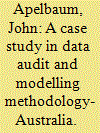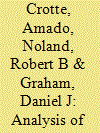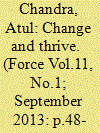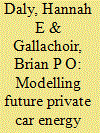|
|
|
Sort Order |
|
|
|
Items / Page
|
|
|
|
|
|
|
| Srl | Item |
| 1 |
ID:
091512


|
|
|
|
|
| Publication |
2009.
|
| Summary/Abstract |
The purpose of the paper is to outline a rigorous, spatially consistent and cost-effective transport planning tool that projects travel demand, energy and emissions for all modes associated with domestic and international transport. The planning tool (AuseTran) is a multi-modal, multi-fuel and multi-regional macroeconomic and demographic-based computational model of the Australian transport sector that overcomes some of the gaps associated with existing strategic level transport emission models. The paper also identifies a number of key data issues that need to be resolved prior to model development with particular reference to the Australian environment. The strategic model structure endogenously derives transport demand, energy and emissions by jurisdiction, vehicle type, emission type and transport service for both freight and passenger transport. Importantly, the analytical framework delineates the national transport task, energy consumed and emissions according to region, state/territory of origin and jurisdictional protocols, provides an audit mechanism for the evaluation of the methodological framework, integrates a mathematical protocol to derive time series FFC emission factors and allows for the impact of non-registered road vehicles on transport, fuel and emissions.
|
|
|
|
|
|
|
|
|
|
|
|
|
|
|
|
| 2 |
ID:
097346


|
|
|
|
|
| Publication |
2010.
|
| Summary/Abstract |
The majority of evidence on gasoline demand elasticities is derived from models based on national data. Since the largest growth in population is now taking place in cities in the developing world it is important that we understand whether this national evidence is applicable to demand conditions at the local level. The aim of this paper is to estimate and compare gasoline per vehicle demand elasticities at the national and local levels in Mexico. National elasticities with respect to price, income, vehicle stock and metro fares are estimated using both a time series cointegration model and a panel GMM model for Mexican states. Estimates for Mexico City are derived by modifying national estimates according to mode shares as suggested by Graham and Glaister (2006), and by estimating a panel Within Groups model with data aggregated by borough. Although all models agree on the sign of the elasticities the magnitudes differ greatly. Elasticities change over time and differ between the national and local levels, with smaller price responses in Mexico City. In general, price elasticities are smaller than those reported in the gasoline demand surveys, a pattern previously found in developing countries. The fact that income and vehicle stock elasticities increase over time may suggest that vehicles are being used more intensively in recent years and that Mexico City residents are purchasing larger vehicles. Elasticities with respect to metro fares are negligible, which suggests little substitution between modes. Finally, the fact that fuel efficiency elasticities are smaller than vehicle stock elasticities suggests that vehicle stock size, rather than its composition, has a larger impact on gasoline consumption in Mexico City.
|
|
|
|
|
|
|
|
|
|
|
|
|
|
|
|
| 3 |
ID:
125963


|
|
|
|
|
| Publication |
2013.
|
| Summary/Abstract |
According to Airbus Military over the next three decades, 'the increasing air transport demands will generate the need for some 2,400 multi-role airlifters, with approximately 1,250 of these in the light/medium category'.
India's requirements alone could account for approximately 10 per cent of that market over the next 10 years. The Indian Air Force (IAF) plans to increase its tonnage carrying capacity from 500 tonnes to 1,500 tonnes by 2022. The IAF is fully committed to supporting the Indian Army in the air maintenance task, its Fixed Wing assets carrying in excess of 25,000 tonnes annually. This capacity will be enhanced with the arrival of upgraded and new aircraft with higher payloads and enhanced avionics for higher sortie generation rates
|
|
|
|
|
|
|
|
|
|
|
|
|
|
|
|
| 4 |
ID:
110721


|
|
|
|
|
| Publication |
2011.
|
| Summary/Abstract |
Targeted measures influencing vehicle technology are increasingly a tool of energy policy makers within the EU as a means of meeting energy efficiency, renewable energy, climate change and energy security goals. This paper develops the modelling capacity for analysing and evaluating such legislation, with a focus on private car energy demand. We populate a baseline car stock and car activity model for Ireland to 2025 using historical car stock data. The model takes account of the lifetime survival profile of different car types, the trends in vehicle activity over the fleet and the fuel price and income elasticities of new car sales and total fleet activity. The impacts of many policy alternatives may only be simulated by such a bottom-up approach, which can aid policy development and evaluation. The level of detail achieved provides specific insights into the technological drivers of energy consumption, thus aiding planning for meeting climate targets. This paper focuses on the methodology and baseline scenario. Baseline results for Ireland forecast a decline in private car energy demand growth (0.2%, compared with 4% in the period 2000-2008), caused by the relative growth in fleet efficiency compared with activity.
|
|
|
|
|
|
|
|
|
|
|
|
|
|
|
|
|
|
|
|
|